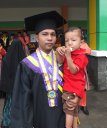 LMS-SPADA INDONESIA
LMS-SPADA INDONESIA
Weekly outline
-
Lecturers

Leil Badrah Zaki S.Pd., M.Pd
NIDN: 1025108801
Email: leil@uib.ac.id
Universitas Internasional Batam
Riyadi Saputra S.Pd., M.Pd
NIDN: 1025108801
mail:riyadisaputra732@ymail.com
Universitas Dharmas IndonesiaCourse Description:
This course is intended to develop knowledge of adult learning and hone understanding of widely used instructional design models specifically for teaching EFL. The program intends to equip the participants with skills to design and analyze professional learning resources. The students will learn the essentials of designing and developing measurable instructional programs informed by fundamental learning theories to meet a variety of learner needs. The participants will be able to design and develop online learning management systems with the use of ICT. at the end of the course, the students are expected to be able to apply the principles of instructional design following a step-by-step model from needs assessment to evaluation and build a solid understanding of the process of a learning design.Credit : 3 sks
Course Learning Outcomes:- CPMK 1 Students are able to identify the use of ICT applied in the development and practice of learning English and correlate it with educational principles and theories regarding approaches, strategies, methods, techniques, and learning models
- CPMK 2 Students are able to identify the concepts and theories of planning and managing ICT-based resources in the administration of classes, schools and educational institutions for which they are responsible, and evaluate their activities comprehensively.
- CPMK 3 Students are able to analyze the need for ICT in the scope of English language learning at every level of an educational unit in Indonesia.
- CPMK 4 Students are able to apply educational principles and theories regarding approaches, strategies, methods, techniques, and learning models in ICT-based learning media at every level of educational units in Indonesia
- CPMK 5 Students are able to design digital-based learning tools for online learning creatively, innovatively, and based on the results of needs analysis by applying logical, critical, systematic, and innovative thinking.
-
Assess your role and your opinion about your group discussin
-
Students are able to:
1. Define visual literacy in your own words and identify two general strategies that you may use to teach visual, audio and video literacy.
2. Name six types of visuals and describe an example of each. 3. Describe the roles that visual, audio and video play in learning.
4. Identify methods for viewing visual, audio and videoin the classroom.
5. Describe the advantages, limitations, and integration ofvisual, audio and video.
6. State in your own words the goals that good visual, audio and video design aims to achieve.
7. Discuss four techniques for creating visual, audio and video 8. Discuss two methods for designing and creating visual, audio and video-
One of the best things about Canva is that it allows us to take visual learning to a new level: Students and teachers can become “design thinkers,” meaning we can become skilled at imagining and creating solutions to problems rather than identifying existing ones. Learning and teaching happen as we envision, create, share, and revise.
-
Video has become an important component of many flipped, blended, and online classes, but ensuring that videos are helping students involves taking a deeper look at video design and production. The key to designing effective educational videos is to begin with clear instructional intentions and follow research-based design principles.
-
This step involves planning your teaching role for utilizing the resources (technology, media, and materials) to help students achieve the learning objectives. To do this, follow the 5 Ps process: Preview the resources; Prepare the resources; Prepare the environment; Prepare the learners; and Provide the learning experience. Watch this video and discuss your project progress in implementing technology in the partnered schools!!
-
Share your opinion and ideas related to the given statements an questions. Your answer will reflect the understanding of the materials for every topics.
-
